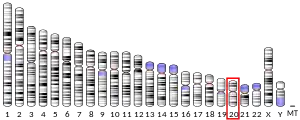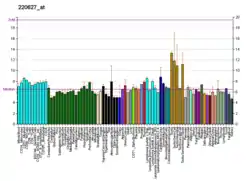| CST8 | |||||||||||||||||||||||||||||||||||||||||||||||||||
|---|---|---|---|---|---|---|---|---|---|---|---|---|---|---|---|---|---|---|---|---|---|---|---|---|---|---|---|---|---|---|---|---|---|---|---|---|---|---|---|---|---|---|---|---|---|---|---|---|---|---|---|
| Identifiers | |||||||||||||||||||||||||||||||||||||||||||||||||||
| Aliases | CST8, CRES, CTES5, cystatin 8 | ||||||||||||||||||||||||||||||||||||||||||||||||||
| External IDs | OMIM: 608683 MGI: 107161 HomoloGene: 4011 GeneCards: CST8 | ||||||||||||||||||||||||||||||||||||||||||||||||||
| |||||||||||||||||||||||||||||||||||||||||||||||||||
| |||||||||||||||||||||||||||||||||||||||||||||||||||
| |||||||||||||||||||||||||||||||||||||||||||||||||||
| |||||||||||||||||||||||||||||||||||||||||||||||||||
| |||||||||||||||||||||||||||||||||||||||||||||||||||
| Wikidata | |||||||||||||||||||||||||||||||||||||||||||||||||||
| |||||||||||||||||||||||||||||||||||||||||||||||||||
Cystatin-8 is a protein that in humans is encoded by the CST8 gene.[5][6]
The cystatin superfamily encompasses proteins that contain multiple cystatin-like sequences. Some of the members are active cysteine protease inhibitors, while others have lost or perhaps never acquired this inhibitory activity. There are three inhibitory families in the superfamily, including the type 1 cystatins (stefins), type 2 cystatins and the kininogens. The type 2 cystatin proteins are a class of cysteine proteinase inhibitors found in a variety of human fluids and secretions. The cystatin locus on chromosome 20 contains the majority of the type 2 cystatin genes and pseudogenes. This gene is located in the cystatin locus and encodes a protein similar to type 2 cystatins. The protein exhibits highly tissue-specific expression in the reproductive tract, suggesting implicit roles in reproduction. Alternative splicing identified in mouse is suggested in human based on EST evidence but the full-length nature of putative variants has not been determined.[6]
References
- 1 2 3 GRCh38: Ensembl release 89: ENSG00000125815 - Ensembl, May 2017
- 1 2 3 GRCm38: Ensembl release 89: ENSMUSG00000027442 - Ensembl, May 2017
- ↑ "Human PubMed Reference:". National Center for Biotechnology Information, U.S. National Library of Medicine.
- ↑ "Mouse PubMed Reference:". National Center for Biotechnology Information, U.S. National Library of Medicine.
- ↑ Cornwall GA, Hann SR (Aug 1995). "Transient appearance of CRES protein during spermatogenesis and caput epididymal sperm maturation". Mol Reprod Dev. 41 (1): 37–46. doi:10.1002/mrd.1080410107. PMID 7619504. S2CID 22214233.
- 1 2 "Entrez Gene: CST8 cystatin 8 (cystatin-related epididymal specific)".
External links
Further reading
- Brown WM, Dziegielewska KM (1997). "Friends and relations of the cystatin superfamily--new members and their evolution". Protein Sci. 6 (1): 5–12. doi:10.1002/pro.5560060102. PMC 2143511. PMID 9007972.
- Ramachandran P, Boontheung P, Xie Y, et al. (2006). "Identification of N-linked glycoproteins in human saliva by glycoprotein capture and mass spectrometry". J. Proteome Res. 5 (6): 1493–503. doi:10.1021/pr050492k. PMID 16740002.
- Gerhard DS, Wagner L, Feingold EA, et al. (2004). "The Status, Quality, and Expansion of the NIH Full-Length cDNA Project: The Mammalian Gene Collection (MGC)". Genome Res. 14 (10B): 2121–7. doi:10.1101/gr.2596504. PMC 528928. PMID 15489334.
- Strausberg RL, Feingold EA, Grouse LH, et al. (2003). "Generation and initial analysis of more than 15,000 full-length human and mouse cDNA sequences". Proc. Natl. Acad. Sci. U.S.A. 99 (26): 16899–903. Bibcode:2002PNAS...9916899M. doi:10.1073/pnas.242603899. PMC 139241. PMID 12477932.
- Wassler M, Syntin P, Sutton-Walsh HG, et al. (2003). "Identification and characterization of cystatin-related epididymal spermatogenic protein in human spermatozoa: localization in the equatorial segment". Biol. Reprod. 67 (3): 795–803. doi:10.1095/biolreprod.102.003970. PMID 12193387.
- Deloukas P, Matthews LH, Ashurst J, et al. (2002). "The DNA sequence and comparative analysis of human chromosome 20". Nature. 414 (6866): 865–71. Bibcode:2001Natur.414..865D. doi:10.1038/414865a. PMID 11780052.
- Cornwall GA, Hsia N, Sutton HG (1999). "Structure, alternative splicing and chromosomal localization of the cystatin-related epididymal spermatogenic gene". Biochem. J. 340 (Pt 1): 85–93. doi:10.1042/0264-6021:3400085. PMC 1220225. PMID 10229662.
- Thiesse M, Millar SJ, Dickinson DP (1994). "The human type 2 cystatin gene family consists of eight to nine members, with at least seven genes clustered at a single locus on human chromosome 20". DNA Cell Biol. 13 (2): 97–116. doi:10.1089/dna.1994.13.97. PMID 8179826.
- Dickinson DP, Zhao Y, Thiesse M, Siciliano MJ (1995). "Direct mapping of seven genes encoding human type 2 cystatins to a single site located at 20p11.2". Genomics. 24 (1): 172–5. doi:10.1006/geno.1994.1595. PMID 7896273.
- Dickinson DP, Thiesse M, Dempsey LD, Millar SJ (1993). "Genomic cloning, physical mapping, and expression of human type 2 cystatin genes". Crit. Rev. Oral Biol. Med. 4 (3–4): 573–80. doi:10.1177/10454411930040034401. PMID 7690606.
- Saitoh E, Isemura S, Sanada K, et al. (1989). "Cystatin superfamily. Evidence that family II cystatin genes are evolutionarily related to family III cystatin genes". Biol. Chem. Hoppe-Seyler. 369 Suppl: 191–7. PMID 3202964.
- Cornwall GA, Orgebin-Crist MC, Hann SR (1992). "The CRES gene: a unique testis-regulated gene related to the cystatin family is highly restricted in its expression to the proximal region of the mouse epididymis". Mol. Endocrinol. 6 (10): 1653–64. doi:10.1210/mend.6.10.1280328. PMID 1280328.
External links
- CST8 human gene location in the UCSC Genome Browser.
- CST8 human gene details in the UCSC Genome Browser.




